 |
| November 25, 2014 | Volume 10 Issue 44 |
Designfax weekly eMagazine
Archives
Partners
Manufacturing Center
Product Spotlight
Modern Applications News
Metalworking Ideas For
Today's Job Shops
Tooling and Production
Strategies for large
metalworking plants
Engineer's Toolbox:
Belaz, maker of world's largest dump truck, wins Swedish Steel Prize 2014
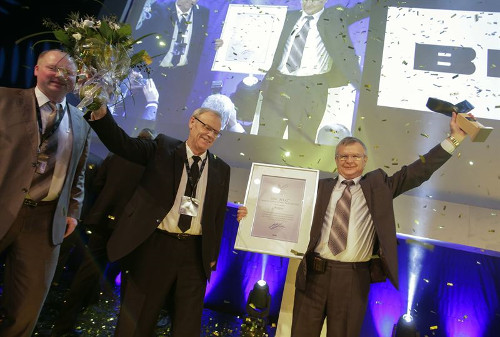
Belaz execs celebrate winning the Swedish Steel Prize 2014.
To optimize production in mines and quarries, the global mining dump truck manufacturer Belaz (from Belarus) had an idea: Create the world's largest dump truck with a 25 percent larger payload capacity than conventional trucks, while minimizing fuel consumption for lower costs per load. That's a tall order for a truck that has a capacity of 450 tons.
That innovation led to the company being named the winner of the Swedish Steel Prize 2014 on the night of November 20, 2014, in Stockholm. The prize was awarded for the company's new axel suspension construction and swivel carriage made from high-strength steel on the Belaz 75710.
The prize
The aim of the Swedish Steel Prize is to inspire, encourage, and disseminate knowledge about high-strength steel and the possibilities for developing lighter, safer, and more environmentally friendly products. SSAB, a Nordic and US-based steel company with a global reach, instituted the Swedish Steel Prize in 1999.
As the winner, Belaz received an award of SEK 100,000 (over $15,000), a statuette, and some considerable envy from industry peers, because this is a very highly regarded prize. The prize ceremony concluded a two-day-long event, where hundreds of international representatives from the engineering and industrial sectors participated in plant visits and seminars.
The BIG winner
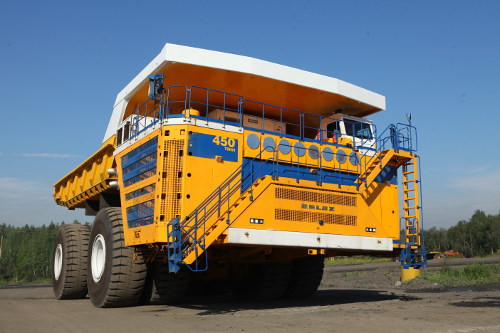
Engineering and building the massive truck meant overcoming a major challenge. Higher payloads in dump trucks are directly connected to tire size. And currently, the largest tires available were already being used on Belaz's next-biggest dump truck model with a load capacity of 360 tons.
"The main motivation was to produce the biggest dump truck that could deliver the most capacity with the lowest fuel consumption," said Leonid Trukhnov, First Deputy General Design Engineer -- Mining Equipment Chief Design Engineer, Belaz.
The solution to increasing payload was found in the weight distribution of the dump truck.
The rear axel of conventional trucks typically carries roughly 70 percent of the load. In order to increase payload capacity, the weight would have to be evenly distributed over both the front and rear of the truck. To do this, Belaz needed to shift weight forward and use four tires in the front and four in the rear. A moveable axel system with slewing bearings was required.
The high-strength steel Weldox 700F, from SSAB, in 110-mm and 125-mm plates was chosen for the manufacturing of the swivel carriage, a component of the truck suspension system between the axle and frame that interconnects them together with a bearing. Hardox 450 was used in the dump truck body. All parts were preprocessed by SSAB in Sweden and assembled on site in Belarus.
Weldox is a structural high-strength steel for heavy and demanding applications, however, it also performs well in the workshop and can be welded with conventional techniques.
When it was completed, the Belaz 75710 achieved its payload goal of 450 tons, an entire 90 tons more than the company's next-largest dump truck. It has a top speed of 60 kph and 40 kph when fully loaded and climbing a 10 percent gradient. The Belaz 75710 is able to work in the harshest mining conditions in the world, down to -60 C at almost 5,000 meters above sea level. It is over 20 m long, nearly 10 m wide, and 8 m high. The turning diameter is about 20 m.
"The dump truck is also 180-mm lower than the old one, which is very important for loading mechanisms as well as stability and safety," said Trukhnov. Currently, one Belaz 75710 dump truck has been produced and already is in operation at a coal mine in Siberia. The second one is in production, and there are already five more on order for 2015.
"Belaz has boldly gone beyond the boundaries of what has earlier been considered possible using available technology," said Gregoire Parenty, Chairman of the jury and Executive Vice President and Head of Market Development SSAB.
The other finalists
The jury chose four innovations from the mining, forestry, and transportation industries as finalists for this year's prize. The three other finalists were, Santander Equipos from Chile, Timo Penttimies from Finland, and Vale from Brazil.
Santander Equipos from Chile: Streamlined, lightweight truck trailer
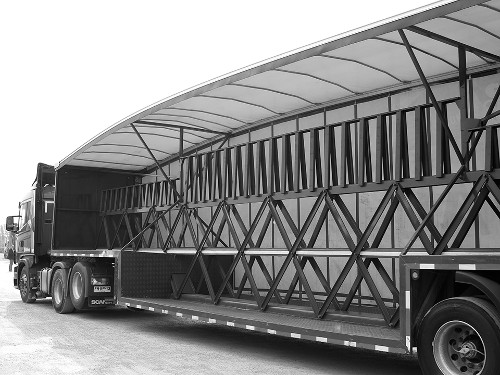
The Chilean trailer manufacturer Santander Equipos was nominated for developing a new and innovative lightweight truck trailer for transporting a large amount of freight.
The advantage of the so-called Cross-Linked Beverage Trailer is a significantly lower weight compared with traditional truck trailers, which means higher cargo efficiency, less fuel consumption, and lower maintenance costs.
The structure of truck trailers has not evolved very much since it was first designed, with two frame beams, axles, wheels, and tow hitch -- often made with heavy, common steel. Most parts are welded. However, the Chilean company developed an entirely new streamlined structure, the first of its kind in all of Latin America.
The idea to manufacture an optimized beverage trailer was inspired by Santander Equipos' motivation to help its main customers -- CCU, Chile's largest beer company, and Coca-Cola -- to increase their competitiveness and profitability per unit. Chilean road law caps the total weight of fully loaded trucks at 45 metric tons, so the lighter the truck and its trailer, the more freight it can carry.
"Traditional shoebox-shaped trailers weigh up to 15 metric tons and can transport about 30 metric tons," said Gonzalo Santander, general manager and owner of Santander Equipos. "Today, the optimized trailer, whose front roof curves down to increase aerodynamics at cruising speed, weighs 5.3 metric tons and can carry around 32 tons."
In 2013 Santander Equipos and KSC SSAB, led by Anders Ivarson, began developing a new project of innovation in the beverage transport business.
"The trailer's main characteristic, which uses high-strength steel, is a much lower tare (the weight of a vehicle without considering its cargo)," Santander said. "It weighs about two and a half metric tons less than our previous model; 5,300 kilos instead of 7,800 kilos. That's a significant difference that benefits both the customer and us, because it allows the trailer to carry more freight and puts Santander in a more competitive position."
This innovation means only 10 trips or trucks are needed instead of 11 of the common model to transport the same amount of cargo, a 9.09 percent increase in load capacity.
Santander explained that two SSAB products are used in the new trailer: The main trailer structure is built with Domex 700 MC steel varying from 5 mm to 8 mm, whereas the tow hitch base employs 8-mm Hardox 450. The trailer backbone is a center space frame consisting of three parallel C-beams linked by a diagonal cross member.
Santander aims to produce about 800 Cross-Linked Beverage Trailers for its customers. Increased competition, fluctuating oil prices, and stricter environmental-impact laws are generating a big demand for lighter trailers to replace the heavy, less efficient ones from past decades, despite their long lifespan.
Timo Penttimies from Finland: Forestry gripper
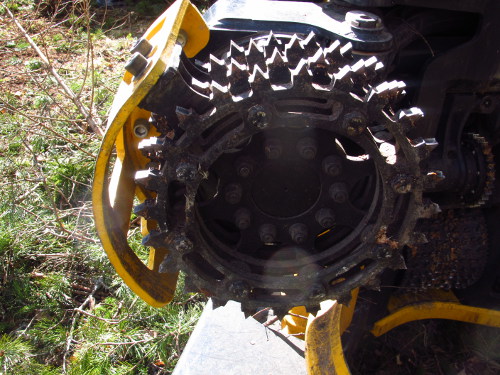
Modern forest harvesters have been developed to cut down trees, remove all of the branches, and cut timber into precisely sawn logs -- all in a matter of seconds. It is a fast and efficient process, but one that exposes parts of the harvester to extreme wear.
Feeder rollers are a good example of this. They are metal or rubber wheels with spikes or chains that grip the tree and propel it forward and backwards through blades that remove the branches. As they wear out, the tree doesn't feed properly through the harvester, and downtime is required when maintenance must be performed.
After years of experiencing feeder rollers wearing out and affecting production, the logger Timo Penttimies decided to do something about it. The result was the TP-roller, a new roller feeder based on the design of a sprocket with sharp and narrow teeth. It utilizes wear-resistant high-strength steel to maximize working life.
"Back in 2007, I started to get the feeling that the rollers I was using were somehow defective as the timber was not reversing properly," said Timo Penttimies, developer of the TP-Roller. "The most common rollers used steel teeth, welded onto the roller, which resulted in poor grip and wore quickly."
The TP-Roller design is a complete departure from other rollers. It is made of the high-strength Hardox 500/600 steel in 10-mm and 15-mm plates. The rollers are laser-cut discs with relief holes and integrated sprocket teeth, which are shouldered to prevent damaging the wood. They range from four to 11 discs per roller, depending on the width and use, and have space for a cleaning device to prevent getting clogged with debris.
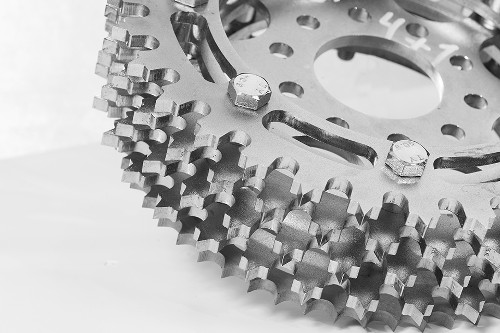
In use, the TP-Roller offers a wide range of benefits. It grips well, even when the wood is hard, thick barked, or has a lot of branches, which improves efficiency. The steep tooth angle and open roller structure enable a low compression load on the roller, which decreases friction. This saves fuel and is gentler on the harvester head.
The use of the high-strength steel Hardox, in combination with an assembled honeycomb-like structure, enables the TP-Roller to come with a 4,000 operating-hour warranty.
"Experience so far strongly indicates that the service life of these rollers may extend even as far as 20,000 operating hours," said Penttimies. "Competitors' rollers have a considerably shorter life span. They are usually made of unhardened steel, so they wear down quickly."
Timo Penttimies chose to use the high-strength steel Hardox from SSAB for its performance consistency as well as its strong and durable wear properties. Despite its strength and toughness, Hardox is still easy to work with and is well-suited for the production of the TP-Roller.
Timo Penttimies has partnered with the German company Grube KG, and its subsidiaries have started selling the TP-Roller in Germany, Austria, Poland, and the Nordic countries. A patent application has been filed, and demand looks promising.
"Many users with extensive previous experience of working with harvesters say that their current TP rollers are the best rollers they have ever used," said Penttimies.
Vale from Brazil: Extra-tough screen makes mining more efficient
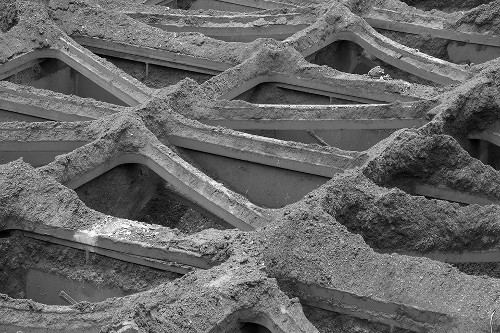
Brazil's Vale was nominated for the Swedish Steel Prize 2014 for designing a new generation of screening grids for application primarily within the large-scale mining industry. The grids use Hardox 450, combining strength and toughness with wear resistance.
Although they didn't win the big prize, Vale was the first-ever recipient of the Swedish Steel Prize People's Choice Award.
The main benefit of the new design is that large chunks of rock no longer block the crusher, making the mining process safer and smoother. The results: Far fewer production interruptions, fewer losses, and a far more efficient iron ore crushing process in general.
"This is a pioneering project. This project was a landmark for Carajas (the biggest iron ore mine in the world) due to its innovation," said Jose Cleber Rodrigues da Silva, Engineering Maintenance supervisor at Carajas. "There was nothing like it before. The screener was created and developed to address the negative impacts of large blocks of iron ore on crushing plants."
The screener is formed by several 3-m x 3.30-m fixed grids with a shape specially designed to withstand the impact of the large rocks and to optmize the iron ore flow. The screens are mounted on a 2-m-high 21-m x 18-m supporting structure, which in turn is placed on top of the ore hopper. Its loading capacity is powerful and huge: up to 1,200 metric tons of iron ore distributed, and it can support impact loads of 120 metric tons.
"The main reason for using Hardox was the combination of high hardness, excellent mechanical properties, and toughness," said Cleber. "In addition, the hardness of 450 HBW ensured the wear resistance to the flow of iron ore on the screen." Cleber said the practical tests yielded even better results than the screener modeling suggested: The reduction of downtime due to (iron ore) block obstruction was 92 percent, and the reduction of costs of losses arising from stoppage amounted to little more than three times the value of the project. This means the project was paid for in just one month.
The solution addressed a recurring and expensive problem in mining: the high incidence of large blocks beyond the capability of feeders that can damage the ore crusher. These blocks, measuring between 2.5 m and 3 m and weighing between 21 and 50 metric tons, can cause plant obstruction and stoppage for hours or even days.
The screener's estimated lifespan is two years in 24/7 operation, which is a long time in mining terms, an industry in which wear and tear are a constant challenge to continuous production. Even a brief halt in mining production can gravely impact economics.
Learn how you can participate in next year's event at www.steelprize.com.
Source: SSAB
Published November 2014
Rate this article
View our terms of use and privacy policy
